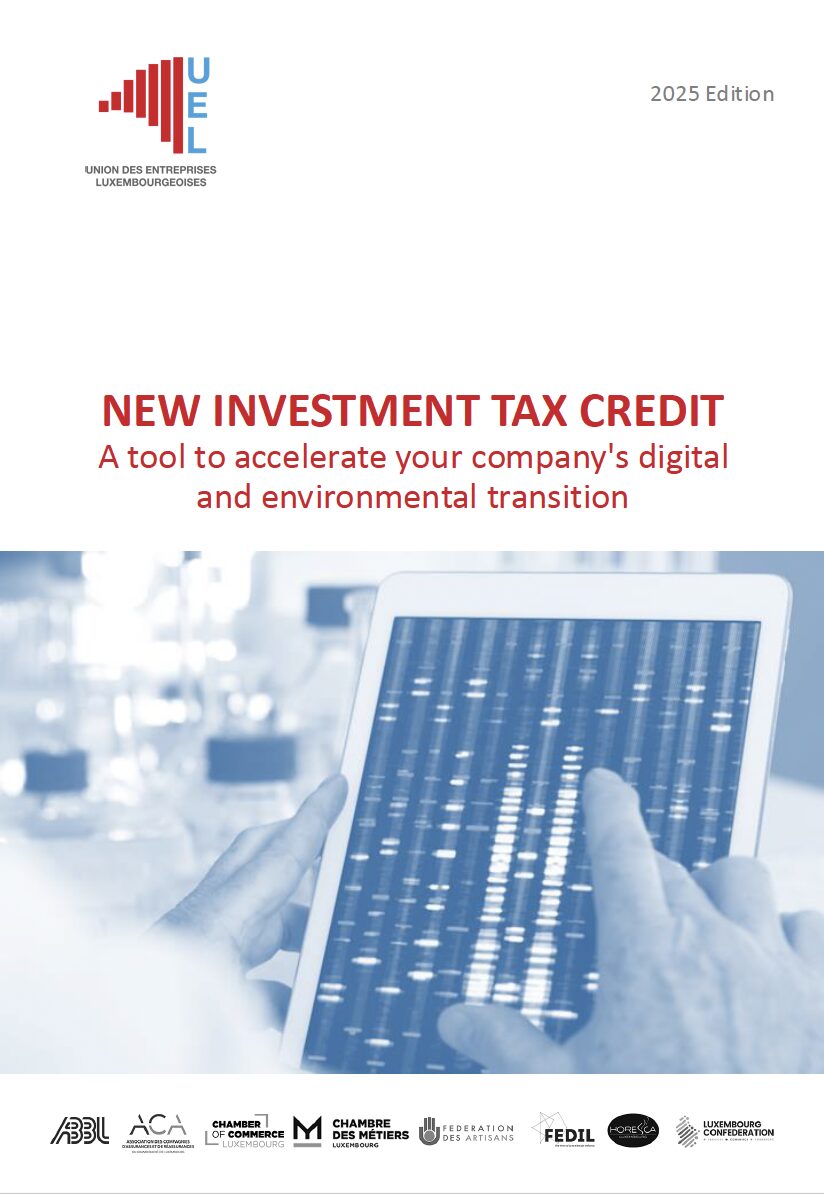A tax incentive for your company’s digital and environmental transformation: focus on the new investment tax credit
12.12.2024
The dual digital and environmental transition is a key challenge for companies in terms of economic performance and maintaining competitiveness, particularly in an ever-changing regulatory context, such as the recent entry into force of the Corporate Sustainability Reporting Directive (CSRD). This new measure is therefore a welcome additional lever, over and above existing subsidy mechanisms, to help companies of all sizes, from large corporations to SMEs, to achieve their related objectives more quickly.
Which companies are eligible?
Commercial, industrial, mining and craft companies embarking on a digital transformation or environmental transition project are eligible to claim this investment tax credit.
What costs are eligible?
The tax credit is computed based on investments and operating expenses incurred as part of a digital transformation project or an ecological and energy transition project. The duration of such a project may not exceed 3 consecutive operating years as from the beginning of the project.
The list of eligible costs is relatively broad, covering:
- The cost of investments in depreciable tangible assets (other than buildings);
- The cost of investments in software or patents, as well as expenses incurred for their use or the right to use them (other than those granted by a related company within the meaning of article 56 LITL);
- Expenses on consultancy, diagnostic and technical support services provided by external service providers which are not related to the normal operating expenses of the business, such as regular tax advice or legal advice, or advertising; and
- Expenses in relation to staff, or staff training, directly assigned to work on the company’s digital transformation project or ecological and energy transition project.
Only expenses incurred as from the introduction of the request for the eligibility certificate (see below) will be taken into account for the computation of the tax credit.
What is the applicable rate?
The tax credit rate is 18% for investments and operating expenses, except for investments in depreciable tangible assets. The latter will be subject to a rate of 6%, in addition to the 12% rate applicable to the tax credit for global investment, a complementary measure already in place. As a result, investments in depreciable tangible assets will also qualify for a cumulative rate of 18%.
The tax credit thus obtained gives rise to an income tax deduction for the tax year following the operating year in which the investments or operating expenses are made. In the absence of sufficient tax, the outstanding tax credit may be deducted from taxes for the following 10 taxable years.
What are the main conditions of application?
To benefit from this measure, the projects implemented within the company must meet certain conditions and objectives.
Eligible digital transformation activities should be innovative in nature, using digital technologies, innovation to be assessed in the context of a holistic approach considering the company’s entire activity and values data.
Environmental transition activities will be eligible if the project aims to reduce the company’s environmental impact, in terms of production or consumption of energy or resources, the said change having to be significant and of a material or technical nature.
Any project aimed at simply complying with a legal or regulatory obligation applicable to a taxpayer (e.g., NIS2, DORA) is not eligible for the tax credit, unless the taxpayer provides proof that the project in question goes significantly beyond simply complying with these obligations.
In addition, each project must meet one or more of the following objectives:
| Digital project objectives | Environmental project objectives |
| 1. Significantly reshape an entire production process
2. Implement an innovative economic model (including circular economy) 3. Significantly reshape the entire provision of service 4. Significantly transform the company’s organization 5. Substantially strengthen IT security across all processes |
1. Significantly improve the energy efficiency of a production process
2. Significantly improve the material efficiency of a production process 3. Significantly decarbonize a production process 4. Reduce production site air pollution (other than CO2 emissions) 5. Produce or store renewable energy for self-consumption needs 6. Promote the extended use of products through reuse |
At this stage, energy-efficient building renovation is not eligible for this measure.
What are the formalities?
To benefit from this tax measure, the company must complete several formalities with the Ministry of the Economy and the Luxembourg tax authorities.
The formalities to be completed are as follows:
- First, companies must apply for a certificate of eligibility with the ministry of the Economy, in order to obtain the ministry’s endorsement of the project. Only expenditure incurred after this application has been submitted will be considered in computing the applicable tax credit (although this does not mean that the project itself cannot have begun before the application was submitted). Requests for an eligibility certificate should be sent to the ministry of the Economy using a dedicated form. Applications can also be made online via MyGuichet.lu or the MyGuichet.lu mobile application;
- Then, the following year, the company must apply for a certificate with the ministry of the Economy attesting to the reality of the investments and operating expenses incurred during the previous operating year (and linked to the project for which the company has received the eligibility certificate). This certificate must be requested by the company no later than two months after the close of the financial year in which the investments and/or operating expenses concerned were made;
- Finally, the company must apply for the tax credit when filing its income tax return for the year in question (with the Luxembourg tax authorities), attaching the certificate previously obtained from the ministry of the Economy.
For more information on this subject, please consult the links below or get in touch with your usual contact at one of our members.
Useful links :
- https://guichet.public.lu/dam-assets/catalogue-pdf/fiscalite/bonification-impot/faq-bonif-impot.pdf
- https://guichet.public.lu/fr/entreprises/fiscalite/bonification-impot-investissement.html
- https://impotsdirects.public.lu/dam-assets/fr/legislation/LIR/texte-coordonn-en-vigueur-au-1er-janvier-2024.pdf
- https://gouvernement.lu/dam-assets/documents/actualites/2023/07-juillet/12-fayot-backes-presentation/prsentation-rforme-bonification-impt.pdf
- https://www.uel.lu/fr/article/retour-sur-la-conference-fiscale-comprendre-la-nouvelle-bonification-dimpot-pour-investissement-du-29-avril-2024/
Our members


